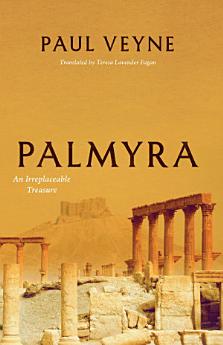Palmyra: An Irreplaceable Treasure
апр 2017. · University of Chicago Press
5,0star
1 recenzijareport
E-knjiga
128
Stranica
family_home
Ispunjava uslove
info
reportOcene i recenzije nisu verifikovane Saznajte više
O ovoj e-knjizi
A “comprehensive, passionate” portrait of the magnificent ancient city destroyed by ISIS: “Veyne speaks of Palmyra as one might of a lost lover” (The Spectator).
Located northeast of Damascus, in an oasis surrounded by palms and two mountain ranges, the ancient city of Palmyra has the aura of myth. According to the Bible, the city was built by Solomon. Regardless of its actual origins, it was an influential city, serving for centuries as a caravan stop for those crossing the Syrian Desert. It became a Roman province under Tiberius and served as the most powerful commercial center in the Middle East between the first and the third centuries CE. But when the citizens of Palmyra tried to break away from Rome, they were defeated, marking the end of the city’s prosperity.
The magnificent monuments from that earlier era of wealth, a resplendent blend of Greco-Roman architecture and local influences, stretched over miles and were among the most significant buildings of the ancient world—until the arrival of ISIS. In 2015, ISIS fought to gain control of the area because it was home to a prison where many members of the outlawed Muslim Brotherhood had been held, and ISIS went on to systematically destroy the city and murder many of its inhabitants, including the archaeologist Khaled al-Asaad, the antiquities director of Palmyra.
In this concise history, Paul Veyne offers a beautiful and moving look at this significant lost city and why it was—and still is—important. Today, we can appreciate the majesty of Palmyra only through its pictures and stories, and this “elegant” book offers a beautifully illustrated memorial that also serves as a lasting guide to a cultural treasure (Common Knowledge).
“Veyne, the most eminent living historian of Rome, has written an elegiac lament on the meaning for world history of this looted city. . . . offers an excellent survey of the relationship between the city and the wider Roman Empire.” —Times Literary Supplement
“Veyne surveys the city’s art and architecture, its class composition, the fire and folly of Queen Zenobia, its entire evolution.” —SFGate
Located northeast of Damascus, in an oasis surrounded by palms and two mountain ranges, the ancient city of Palmyra has the aura of myth. According to the Bible, the city was built by Solomon. Regardless of its actual origins, it was an influential city, serving for centuries as a caravan stop for those crossing the Syrian Desert. It became a Roman province under Tiberius and served as the most powerful commercial center in the Middle East between the first and the third centuries CE. But when the citizens of Palmyra tried to break away from Rome, they were defeated, marking the end of the city’s prosperity.
The magnificent monuments from that earlier era of wealth, a resplendent blend of Greco-Roman architecture and local influences, stretched over miles and were among the most significant buildings of the ancient world—until the arrival of ISIS. In 2015, ISIS fought to gain control of the area because it was home to a prison where many members of the outlawed Muslim Brotherhood had been held, and ISIS went on to systematically destroy the city and murder many of its inhabitants, including the archaeologist Khaled al-Asaad, the antiquities director of Palmyra.
In this concise history, Paul Veyne offers a beautiful and moving look at this significant lost city and why it was—and still is—important. Today, we can appreciate the majesty of Palmyra only through its pictures and stories, and this “elegant” book offers a beautifully illustrated memorial that also serves as a lasting guide to a cultural treasure (Common Knowledge).
“Veyne, the most eminent living historian of Rome, has written an elegiac lament on the meaning for world history of this looted city. . . . offers an excellent survey of the relationship between the city and the wider Roman Empire.” —Times Literary Supplement
“Veyne surveys the city’s art and architecture, its class composition, the fire and folly of Queen Zenobia, its entire evolution.” —SFGate
Ocene i recenzije
5,0
1 recenzija
O autoru
Paul Veyne is a French archaeologist and historian and an honorary professor at the Collège de France. He is the author of several books in French as well as Did the Greeks Believe in Their Myths?, also published by the University of Chicago Press. Teresa Lavender Fagan is a freelance translator living in Chicago; she has translated numerous books for the University of Chicago Press and other publishers.
Ocenite ovu e-knjigu
Javite nam svoje mišljenje.
Informacije o čitanju
Pametni telefoni i tableti
Instalirajte aplikaciju Google Play knjige za Android i iPad/iPhone. Automatski se sinhronizuje sa nalogom i omogućava vam da čitate onlajn i oflajn gde god da se nalazite.
Laptopovi i računari
Možete da slušate audio-knjige kupljene na Google Play-u pomoću veb-pregledača na računaru.
E-čitači i drugi uređaji
Da biste čitali na uređajima koje koriste e-mastilo, kao što su Kobo e-čitači, treba da preuzmete fajl i prenesete ga na uređaj. Pratite detaljna uputstva iz centra za pomoć da biste preneli fajlove u podržane e-čitače.






